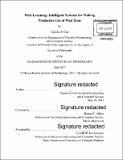| dc.contributor.advisor | Robert C. Miller. | en_US |
| dc.contributor.author | Cai, Carrie Jun | en_US |
| dc.contributor.other | Massachusetts Institute of Technology. Department of Electrical Engineering and Computer Science. | en_US |
| dc.date.accessioned | 2017-10-18T15:08:07Z | |
| dc.date.available | 2017-10-18T15:08:07Z | |
| dc.date.copyright | 2017 | en_US |
| dc.date.issued | 2017 | en_US |
| dc.identifier.uri | http://hdl.handle.net/1721.1/111875 | |
| dc.description | Thesis: Ph. D., Massachusetts Institute of Technology, Department of Electrical Engineering and Computer Science, 2017. | en_US |
| dc.description | Cataloged from PDF version of thesis. | en_US |
| dc.description | Includes bibliographical references (pages [243]-259). | en_US |
| dc.description.abstract | Every day, millions of people set long-term goals, such as learning a skill, developing a habit, or completing a project. Yet, in our busy, time-crunched world, most have difficulty making progress towards these goals. Despite this lack of time, there are numerous moments in a day when people wait, such as waiting for the elevator or waiting for an instant message reply. These fleeting moments could instead be used for completing short, concrete microtasks towards accomplishing long-term goals. This thesis presents novel systems and approaches that enable wait-time productivity. First, WaitChatter enables wait-learning, by automatically detecting when a user is awaiting an instant message reply, and presenting foreign language vocabulary exercises during that time. Second, WaitSuite is a suite of systems that expand wait-learning to diverse kinds of waiting scenarios. Furthermore, given a variety of microtasks, I also demonstrate how chains of microtasks can be ordered in a way that maximizes efficiency and minimizes mental workload. Finally, Deadspace Finder enables peripheral microtasks to be displayed less intrusively, by automatically detecting and placing them into unused screen space. Taken together, these systems demonstrate that wait-time productivity is both feasible and more effective than traditional reminders, making meaningful use of time we didn't know we had. | en_US |
| dc.description.statementofresponsibility | by Carrie J. Cai. | en_US |
| dc.format.extent | 259 pages | en_US |
| dc.language.iso | eng | en_US |
| dc.publisher | Massachusetts Institute of Technology | en_US |
| dc.rights | MIT theses are protected by copyright. They may be viewed, downloaded, or printed from this source but further reproduction or distribution in any format is prohibited without written permission. | en_US |
| dc.rights.uri | http://dspace.mit.edu/handle/1721.1/7582 | en_US |
| dc.subject | Electrical Engineering and Computer Science. | en_US |
| dc.title | Wait-learning : intelligent systems for making productive use of wait time | en_US |
| dc.title.alternative | Wait learning | en_US |
| dc.title.alternative | Intelligent systems for making productive use of wait time | en_US |
| dc.type | Thesis | en_US |
| dc.description.degree | Ph. D. | en_US |
| dc.contributor.department | Massachusetts Institute of Technology. Department of Electrical Engineering and Computer Science | |
| dc.identifier.oclc | 1004860654 | en_US |
